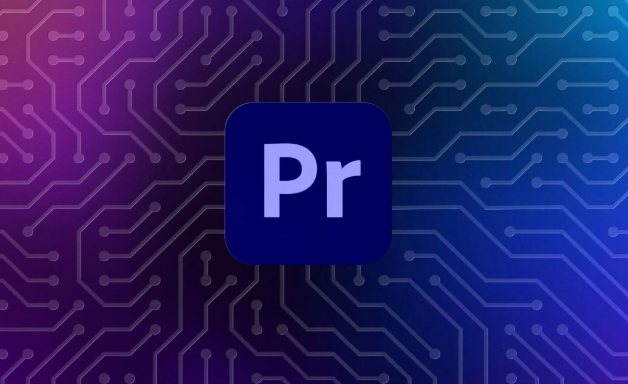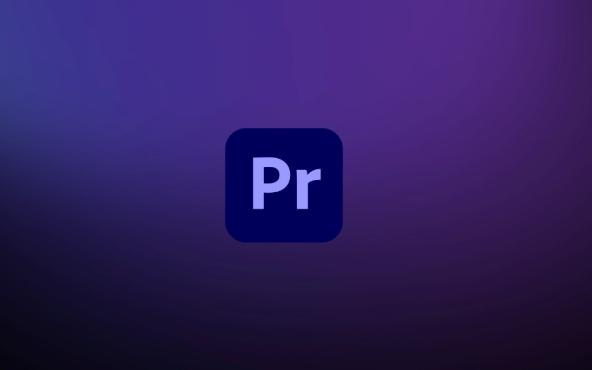Resetting Premiere Pro preferences can solve problems such as interface confusion, failure of functions, or startup crashes. Premiere Pro preferences include interface layout, automatic save path, default project settings, hardware acceleration options and other configurations, which will cause unstable operation when there is an error; reset will restore the initial state. Reset method: 1. When the Windows system is turned off and the software is opened, press and hold Ctrl Alt Shift until the prompt appears, click "Yes"; 2. When the macOS system is turned off and hold Command Option Shift, click "OK" after the prompt. You can also manually delete the preference file: the Windows path is C:\Users\Users\Username\AppData\Roaming\Adobe\Common\Preferences, macOS is /Users/Users/Username/Library/Preferences/Adobe/Common, the file name is com.adobe.PremierePro.plist or similar. It is recommended to delete it after backup. Applicable resets include: frequent software crashes, interface abnormalities, plug-in failure, problem after replacing the working environment or graphics card driver. After reset, you need to reconfigure custom options such as shortcut keys, default sequence settings, media cache paths, etc.

Sometimes when opening Premiere Pro, you will encounter various strange problems, such as interface disorder, failure of functions, or startup crashes. In this case, resetting preferences is usually an effective solution.

What are Premiere Pro preferences?
Premiere Pro's "Preferences" contains a lot of configuration information about the software, such as interface layout, automatic save path, default project settings, hardware acceleration options, etc. If these settings are wrong or conflicted, they may cause the software to run unstable. Resetting preferences means returning these configurations to the initial state, which is equivalent to "starting again".

How to reset preferences in different systems
Windows System
On Windows, you can reset it by using the shortcut key combination:
- Close Premiere Pro
- When you open again, hold down Ctrl Alt Shift immediately (press three keys together) until a prompt window asks if you want to delete the preferences file
- Click "Yes" to complete the reset
macOS system
The operation method of macOS is similar:

- Close Premiere Pro
- When opening the software, hold down Command Option Shift immediately
- Click "OK" after the confirmation prompt appears to clear the current preferences
This approach works with most versions of Premiere Pro, including CC 2020 to the latest versions.
Where is the preferred file?
If you don't want to use shortcut keys, you can also manually find and delete the preference file.
The general path is as follows:
- Windows :
C:\Users\用戶(hù)名\AppData\Roaming\Adobe\Common\Preferences - macOS :
/Users/用戶(hù)名/Library/Preferences/Adobe/Common
In this directory, you will see a file named com.adobe.PremierePro.plist or similar, which is your preference file. You can back it up and delete it just in case.
When should I consider resetting my preferences?
You can try resetting in the following situations:
- The software crashes frequently or fails to start
- The interface displays abnormally, such as the panel not displaying or the arrangement is messy
- Some plug-ins or features suddenly fail
- Problems occurred after changing the working environment or graphics card driver
Of course, after resetting, you may need to reset some customization options, such as shortcut keys, default sequence settings, media cache path, etc. Therefore, it is best to record your commonly used configuration items before execution.
Basically that's it. Although it is not a feature that you need to use every day, knowing how to operate it when you encounter problems can save a lot of trouble.
The above is the detailed content of how to reset Premiere Pro preferences. For more information, please follow other related articles on the PHP Chinese website!

Hot AI Tools

Undress AI Tool
Undress images for free

Undresser.AI Undress
AI-powered app for creating realistic nude photos

AI Clothes Remover
Online AI tool for removing clothes from photos.

Clothoff.io
AI clothes remover

Video Face Swap
Swap faces in any video effortlessly with our completely free AI face swap tool!

Hot Article

Hot Tools

Notepad++7.3.1
Easy-to-use and free code editor

SublimeText3 Chinese version
Chinese version, very easy to use

Zend Studio 13.0.1
Powerful PHP integrated development environment

Dreamweaver CS6
Visual web development tools

SublimeText3 Mac version
God-level code editing software (SublimeText3)

Hot Topics
 how to make text appear one letter at a time in Premiere Pro
Jul 08, 2025 am 12:02 AM
how to make text appear one letter at a time in Premiere Pro
Jul 08, 2025 am 12:02 AM
To display text letter by letter, use PremierePro’s built-in “Typewriter” animation preset or manually adjust the opacity or zoom of each character. 1. Use presets such as "Typewriter-Reveal" in the "EssentialGraphics" panel to directly apply the verbatim effect; 2. Enable character-by-character animation through the "EssentialGraphics panel" and select Opacity or Scale for customization; 3. Set Start and EndOffset to control the animation rhythm and combine keyframes to achieve dynamic changes; 4. You can adjust the offset, add blur or color change to enhance the effect. It is recommended that each letter lasts 0.1-0.2 seconds and is suitable for phrases rather than long paragraphs.
 how to fix red frames in Premiere Pro
Jul 07, 2025 am 12:16 AM
how to fix red frames in Premiere Pro
Jul 07, 2025 am 12:16 AM
The red box appears in PremierePro because the preview file is not generated or the material path is incorrect. Common reasons include just imported projects, material path changes, insufficient cache space, or failed proxy files loading. Solution: 1. Wait for automatic cache generation; 2. Manually generate preview rendering timeline; 3. Check and relink missing materials; 4. Clean and rebuild media cache. When using proxy clips, you should confirm that the proxy files are correctly associated and appropriately reduce the playback resolution to improve preview fluency.
 how to rotate video in Premiere Pro
Jul 04, 2025 am 01:33 AM
how to rotate video in Premiere Pro
Jul 04, 2025 am 01:33 AM
There are three ways to rotate videos in PremierePro. 1. Use the "Motion" option in the "Effect Control" to accurately adjust the rotation angle, which is suitable for fine operation; 2. Use the "Create Sequence from Clip" function to automatically correct the vertical video direction of the mobile phone, saving time and effort; 3. Use "Crop" and "Zoom" to adjust the screen to fill the screen and avoid black edges to ensure complete output quality.
 how to apply an effect to multiple clips in Premiere Pro
Jul 05, 2025 am 12:22 AM
how to apply an effect to multiple clips in Premiere Pro
Jul 05, 2025 am 12:22 AM
There are three ways to quickly add the same effect to multiple clips in PremierePro: 1. Use the "EffectChainer" tool to first apply the effect to one clip, and then click other clips one by one through the chain icon in the effect panel to apply it in batches; 2. By copying and pasting attributes, right-click the first clip with added effects in the timeline to select copy, then select other clips to right-click to select paste attributes, and only select video or audio effects to paste; 3. Use the adjustment layer to process the video effect, create a new adjustment layer and place it above the target clip, and drag the effect to the adjustment layer to affect all clips below it. The above methods can significantly improve work efficiency and are suitable for the needs of different scenarios.
 how to fade audio in Premiere Pro
Jul 05, 2025 am 12:50 AM
how to fade audio in Premiere Pro
Jul 05, 2025 am 12:50 AM
Adding a fade effect to audio in PremierePro can be achieved in three ways: 1. Use audio transition effects such as "Constant Gain" or "Exponential Fade" and drag directly to the beginning of the audio clip; 2. Manually add volume keyframes in the "Effect Controls" panel, and control fade speed and nature by adjusting the keyframe position and curve; 3. Use the "Trail Mixer" to drag the volume slider in real time to record the operation track, which is suitable for unified management of multi-track audio. Each method has its own advantages. Newbie can choose to quickly achieve the transition effect, advanced users are suitable for manual adjustment or use the track mixer to obtain more refined control. Finally, it is recommended that preview ensures that the audio transition is natural and smooth.
 how to normalize audio in Premiere Pro
Jul 04, 2025 am 12:16 AM
how to normalize audio in Premiere Pro
Jul 04, 2025 am 12:16 AM
NormalizingaudioinPremiereProadjuststheloudestpeakinacliptoatargetlevel,balancingvolumeacrossclips.1.Right-clickaclipandchoose“AudioGain…”2.Select“NormalizeMaxPeakto”andsetatargetlike-1dBor-3dB.3.ClickOKtoapply;thisscaleseachclip’svolumeuniformly.Itw
 how to create a cinematic look in Premiere Pro
Jul 06, 2025 am 12:07 AM
how to create a cinematic look in Premiere Pro
Jul 06, 2025 am 12:07 AM
To bring up a movie-like picture in PremierePro, the key is to adjust the basics and follow the following steps: 1. Use the LumetriColor panel for basic corrections and creative color grading to avoid directly applying presets; 2. Add FilmGrain effect to improve texture but not excessively; 3. Control the details of highlights and shadows, and combine local adjustments to enhance levels; 4. Set appropriate output parameters such as H.264 or ProRes, 10bit color depth to preserve the color grading effect.
 how to make a video look like old film in Premiere Pro
Jul 11, 2025 am 12:04 AM
how to make a video look like old film in Premiere Pro
Jul 11, 2025 am 12:04 AM
If you want the video to present the old movie effect in PremierePro, the core is to adjust color, add noise, simulate film scratches and adjust the frame rate appropriately. 1. Adjust the color style: Use the LumetriColor panel to reduce saturation, increase warm tones, or apply "antique" presets and fine-tune according to the picture; 2. Add particles and scratches: Add appropriate amount of particles through plug-ins or built-in effects, superimpose transparent scratch layers and select the appropriate blending mode; 3. Adjust frame rate and playback speed: Export high frame rate materials to lower frame rates or use frame fusion to simulate the playback rhythm of old movies; 4. Add black edges and slight jitter: Use a mask layer to add black edges, and retain slight shaking through WarpStabilizerVFX to enhance the sense of reality. Each step requires






